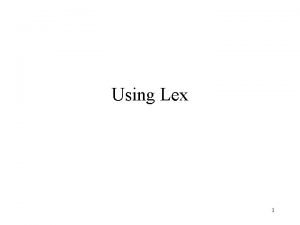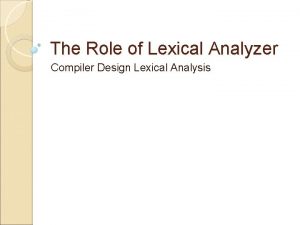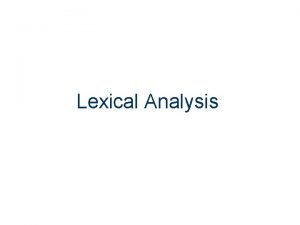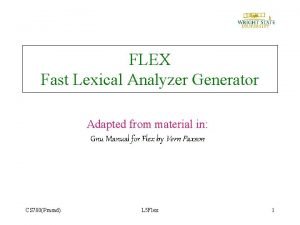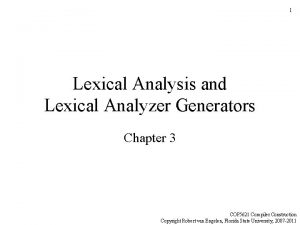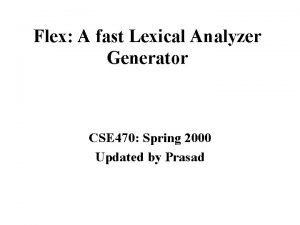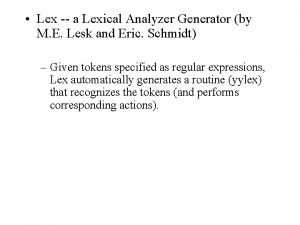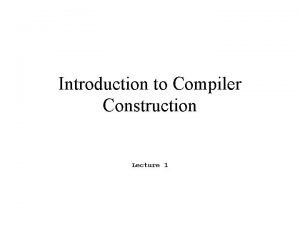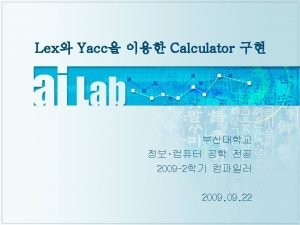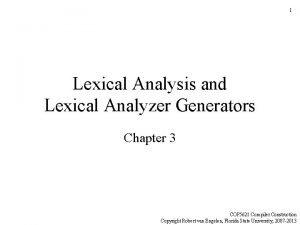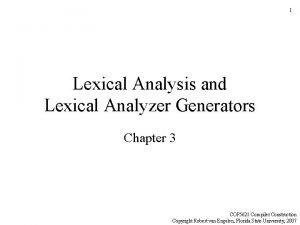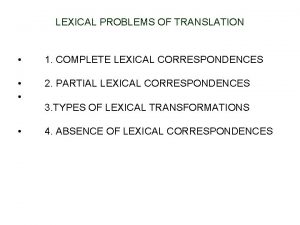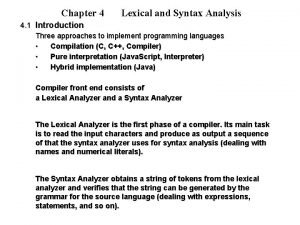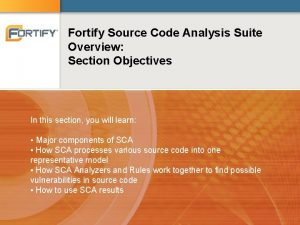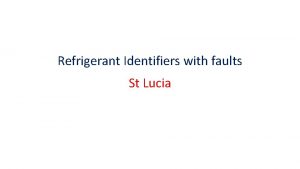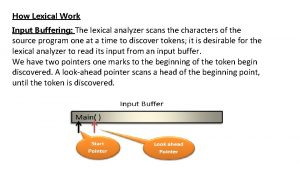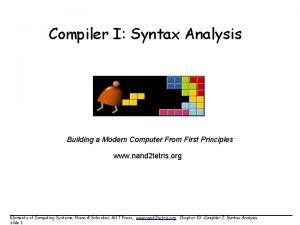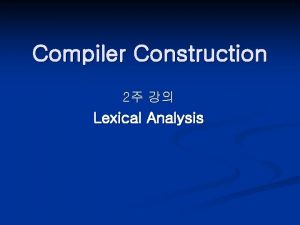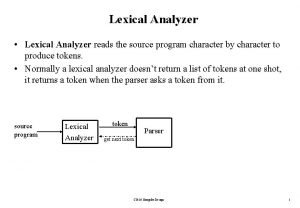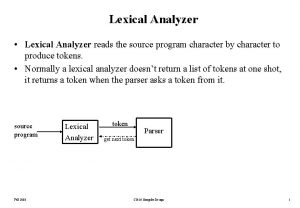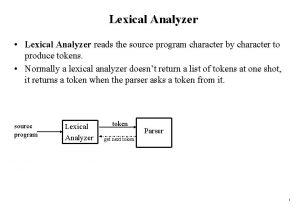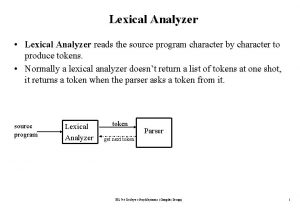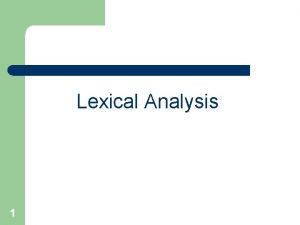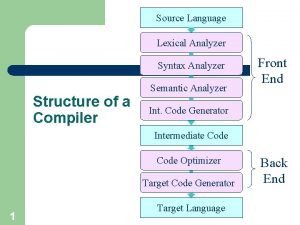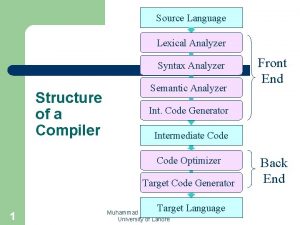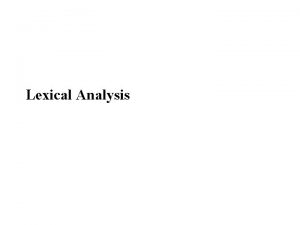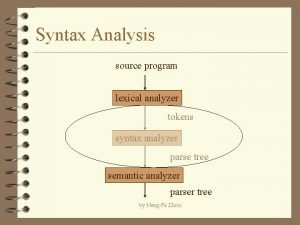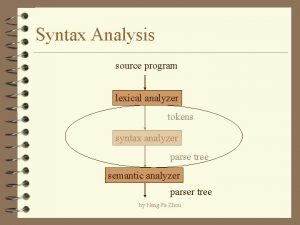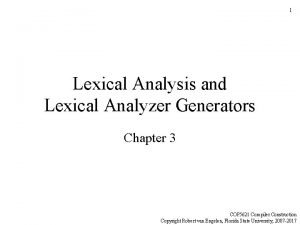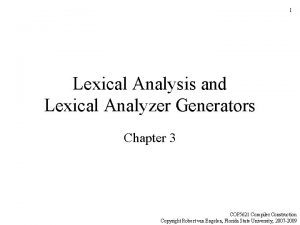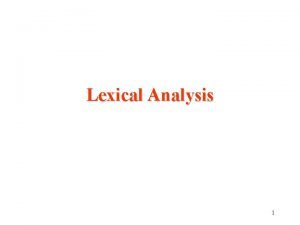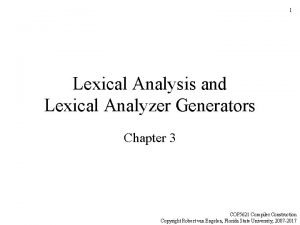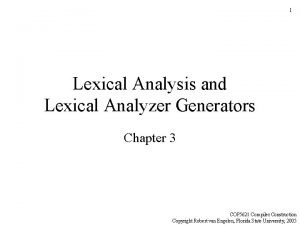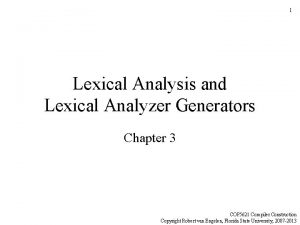Lexical Analysis Lexical Analyzer in Perspective source program





















- Slides: 21

Lexical Analysis

Lexical Analyzer in Perspective source program lexical analyzer token parser get next token symbol table Important Issue: What are Responsibilities of each Box ? Focus on Lexical Analyzer and Parser.

Role of the Lexical Analyzer • Identify the words: Lexical Analysis – Converts a stream of characters (input program) into a stream of tokens. • Also called Scanning or Tokenizing • Identify the sentences: Parsing. – Derive the structure of sentences: construct parse trees from a stream of tokens. Next_token() Next_char() Input character Scanner token Symbol Table Parser

Interaction of Lexical Analyzer with Parser Next_token() Next_char() Input character Scanner token Parser Symbol Table • Often a subroutine of the parser • Secondary tasks of Lexical Analyzer – Strip out comments and white spaces from the source – Correlate error messages with the source program – Preprocessing may be implemented as lexical analysis takes place

Issues in Lexical Analysis • Simplicity/Modularity: Conventions about “words" are often different from conventions about “sentences". • Efficiency: Word identification problem has a much more efficient solution than sentence identification problem. Specialized buffering techniques for reading input characters and processing tokens. • Portability: Input alphabet peculiarities and other device-specific anomalies can be restricted to the lexical analyzer.

Introducing Basic Terminology • What are Major Terms for Lexical Analysis? – TOKEN • A classification for a common set of strings • e. g. , tok_integer_constant – PATTERN • The rules which characterize the set of strings for a token • e. g. , digit followed by zero or more digits – LEXEME • Actual sequence of characters that matches pattern and is classified by a token • e. g. , 32894

Introducing Basic Terminology Token Sample Lexemes Informal Description of Pattern const if if if relation <, <=, =, < >, >, >= < or <= or < > or >= or > id pi, count, D 2 letter followed by letters and digits num 3. 1416, 0, 6. 02 E 23 any numeric constant literal “core dumped” any characters between “ and “ except “

Token Stream • Tokens are terminal symbol in the grammar for the source language • keywords, operators, identifiers, constants, literal strings, punctuation symbols etc. are treated as tokens • Source: if ( x == -3. 1415 ) /* test x */ then. . . • Token Stream: < IF > < LPAREN > < ID, “x” > < EQUALS > < NUM, -3. 14150000 > < RPAREN > < THEN >. . .

Attributes for Tokens • Tokens influence parsing decision; the attributes influence the translation of tokens. • A token usually has only a single attribute – A pointer to the symbol-table entry – Other attributes (e. g. line number, lexeme) can be stored in symbol table Example: E = M * C ** 2 <id, pointer to symbol-table entry for E> <assign_op, > <id, pointer to symbol-table entry for M> <mult_op, > <id, pointer to symbol-table entry for C> <exp_op, > <num, integer value 2>

Terminology • Alphabet ( ) : AKA character class – A finite set of symbols (“characters”) – Examples: = { 1, 0} : binary alphabet = { 1, 2, 3, 4, 5, 6 } : Alphabet on dice outcome • String : AKA Sentence or word – Finite sequence of symbols drawn from the alphabet – Finite in length – Example: abbadc Length of s = |s| • Empty String ( ) – It is a special string of length zero – | |=0 • Language – A set of strings over some fixed alphabet Each string is finite in length, – Examples: L 1 = { a, baa, bccb } but the set may have an infinite number of elements. L 2 = { } Note the difference L 3 = { } L 4 = { , abab, abababab, . . . }

Terminology • Prefix. . . of string s – String obtained by removing zero or more trailing symbols – s = hello – Prefixes: , h, hel, hello • Suffix. . . of string s – String obtained by deleting zero or more of the leading symbols – s = hello – Suffixes: hello, o, • Substring. . . of string s – String obtained by deleting a prefix and a suffix – s = hello – Substrings: . ell, hel, llo, hello, …. – Every prefix or every suffix of s is a substring of s – Not every substring of s is a prefix of suffix of s

Terminology • Proper prefix / suffix / substring. . . of s – String s 1 that is respectively prefix, suffix, or substring of s such that s 1 s and s 1 • Subsequence…. of string s – String formed by deleting zero or more not necessarily contiguous symbols – S = hello – Subsequence: hll, eo, hlo, etc.

Terminology

Terminology • Language – A set of strings – L = {. . . } – M = {. . . } • Union of two languages – – – L M = { s | s is in L or is in M } Example: L = { a, ab } M = { c, dd } L M = { a, ab, c, dd } • Concatenation of two languages – – – L M = { st | s is in L and t is in M } Example: L = { a, ab } M = { c, dd } L M = { ac, add, abc, abdd }

Kleene Closure L* denotes “zero or more concatenations of” L

Positive Closure • Let: L = { a, bc } • Example: L 0 = { } L+ denotes “one or more concatenations of” L L 1 = L = { a, bc } L 2 = LL = { aa, abc, bca, bcbc } L 3 = LLL = { aaa, aabc, abca, abcbc, bcaa, bcabc, bcbca, bcbcbc } . . . etc. . . LN = LN-1 L = LLN-1 • The “Positive Closure” of a language: Note is not included UNLESS it is in L to start with • Example: • L+ = { a, bc, aa, abc, bca, bcbc, aaa, aabc, abca, abcbc, . . . } L 1 L 2 L 3

Example Let: L = { a, b, c, . . . , z } D = { 0, 1, 2, . . . , 9 } D+ = “The set of strings with one or more digits” L D = “The set of all letters and digits (alphanumeric characters)” LD = “The set of strings consisting of a letter followed by a digit” L* = “The set of all strings of letters, including , the empty string” ( L D )* = “Sequences of zero or more letters and digits” L ( ( L D )* ) = “Set of strings that start with a letter, followed by zero or more letters and digits. ”

Language and Regular Expressions • A Regular Expression is a Set of Rules / Techniques for Constructing Sequences of Symbols (Strings) From an Alphabet. • Let Be an Alphabet, r a Regular Expression Then L(r) is the Language that is Characterized by the Rules of r.

Rules for Specifying Regular Expressions • Regular expressions over alphabet 1. is a regular expression that denotes { }. 2. If a is a symbol (i. e. , if a ), then a is a regular expression that denotes {a}. 3. Suppose r and s are regular expressions denoting the languages L(r) and L(s). Then a) b) c) d) (r) | (s) is a regular expression denoting L(r) U L(s). (r)(s) is a regular expression denoting L(r)L(s). (r)* is a regular expression denoting (L(r))*. (r) is a regular expression denoting L(r).

How to “Parse” Regular Expressions • Precedence: – – * has highest precedence. Concatenation has middle precedence. | has lowest precedence. Use parentheses to override these rules. • Examples: – a b* = a (b*) • If you want (a b)* you must use parentheses. – a | b c = a | (b c) • If you want (a | b) c you must use parentheses. • Concatenation and | are associative. – (a b) c = a (b c) = a b c – (a | b) | c = a | (b | c) = a | b | c • Example: – b d | e f * | g a = (b d) | (e (f *)) | (g a)

Example • Let = {a, b} – The regular expression a | b denotes the set {a, b} – The regular expression (a|b) denotes {aa, ab, ba, bb} – The regular expression a* denotes the set of all strings of zero or more a’s. i. e. , { , a, aaa, …. . } – The regular expression (a|b)* denotes the set containing zero or more instances of an a or b. – The regular expression a|a*b denotes the set containing the string a and all strings consisting of zero or more a’s followed by one b.
 Lexical analyzer generator
Lexical analyzer generator Lexeme in compiler design
Lexeme in compiler design Lexical analyzer
Lexical analyzer Flex %x
Flex %x What is lexical analyzer generator
What is lexical analyzer generator Fast lexical analyzer
Fast lexical analyzer Lexical analyzer generator lex
Lexical analyzer generator lex Compiler lecture
Compiler lecture Lexical analyzer 구현
Lexical analyzer 구현 Design of lexical analyzer generator
Design of lexical analyzer generator Design of lexical analyzer generator
Design of lexical analyzer generator Absence of lexical correspondences
Absence of lexical correspondences Lexical analysis and syntax analysis
Lexical analysis and syntax analysis Transient line source technique
Transient line source technique Fortify source code analyzer
Fortify source code analyzer 2 point perspective windows
2 point perspective windows Silo perspective vs business process perspective
Silo perspective vs business process perspective Neutronics ultima id pro
Neutronics ultima id pro Lexical analysis input buffering
Lexical analysis input buffering Gj6 parsing
Gj6 parsing Lexical analysis
Lexical analysis Lexical analysis finite automata
Lexical analysis finite automata
